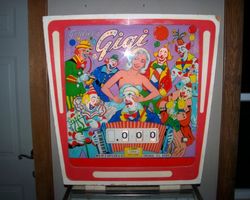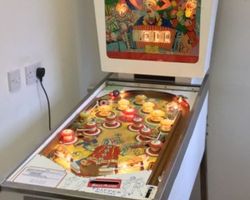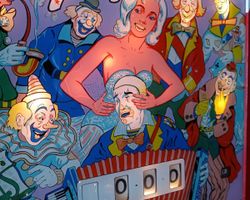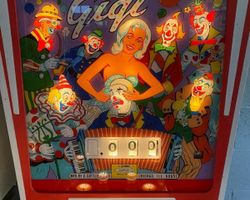Gigi

Average Prices: USD $400 to $1,000
Produced: December, 1963
Production Run: 3,575 units
Machine Type: Electro-mechanical
Players: 1
Design by: Wayne Neyens
Art by: Roy Parker
The pinball machine "Gigi," released by D. Gottlieb & Co. in December 1963, stands as a notable example of electro-mechanical (EM) design from its era. Bearing the model number 202, this single-player machine saw a production run of 3,575 units, a respectable number for its time. At its core, Gigi embodies the charm and mechanical ingenuity that defined Gottlieb's "wedgehead" machines of the early 1960s. The machine's conceptualization and mechanical design were primarily the work of Wayne Neyens, a prolific designer for Gottlieb. Neyens was also credited with the animation and overall concept, ensuring a cohesive vision for the game. Complementing the mechanical design was the distinctive artwork of Roy Parker, whose vibrant and abstract style became synonymous with many Gottlieb titles. A significant milestone for Gigi was its pioneering introduction of an end-of-game points award, a feature that would become a standard across the industry, laying groundwork for more complex scoring mechanics in future pinball designs.
Signature Features and Design
Gigi immediately captivates with its striking visual presentation, primarily attributed to Roy Parker’s artwork. The backglass, in particular, is a highlight, often described as a piece of pop art, featuring an abstract circus or carnival theme replete with showgirls, stylized clowns, and even a dachshund. This artistic choice provides a backdrop that is both whimsical and sophisticated, a departure from more literal interpretations of themes common in other machines. The playfield artwork mirrors this aesthetic, utilizing bold colors and clean lines that make elements stand out.
From a mechanical standpoint, Gigi is defined by its abundance of bumpers, totaling fourteen across the playfield—three active pop bumpers and eleven passive bumpers. This high concentration of bumpers dictates a play style centered around precise shots and careful nudging to control the ball’s trajectory within the dense bumper array. The machine features two flippers, positioned to offer control over the ball as it descends, two slingshots that add an element of unpredictability, five rollover buttons for point accumulation, and two standup targets. The sound design is minimalist, characteristic of EM machines, relying on the satisfying chime of a single bell and the distinct knock of a knocker to signal achievements and replays.
The core innovation that truly sets Gigi apart is its unique bumper system. The playfield incorporates two distinct "chevrons" of numbered passive bumpers, one set illuminated in red and the other in yellow. The ingenious mechanic here is that hitting a bumper of a specific number in one color will simultaneously extinguish the corresponding bumper of the same number in the other color. This creates a strategic challenge: players must carefully manage which color set they are attempting to complete. The objective is to light all the bumpers of either the red or yellow chevron. Successfully achieving this not only scores an "Advance" but also lights the "Speshul" rollover lanes, offering a potential replay. This interplay between the red and yellow bumper sets is a defining characteristic, forcing players to adapt their strategy based on the current state of the playfield.
Playfield and Mechanics
The playfield of Gigi is meticulously laid out to facilitate its signature bumper-centric gameplay. The upper and mid-playfield are dominated by the fourteen bumpers, strategically positioned to create a dynamic and somewhat unpredictable environment for the ball. The arrangement of the red and yellow bumper chevrons is central to the game's challenge. Players aim to navigate the ball through this maze of bumpers, attempting to light a complete set of either color. Each hit on a numbered bumper lights it up, but critically, also extinguishes the corresponding numbered bumper of the opposite color. This creates a constant strategic decision-making process: do you commit to lighting the red set, or pivot to the yellow if the ball path favors it?
Below the primary bumper array, the playfield features five rollover buttons and two standup targets, providing additional scoring opportunities and contributing to the overall objective. The flipper area is characterized by a wide gap between the two flippers and somewhat generous outlanes. This design contributes significantly to the game's reputation for difficulty, as quick drains are a common occurrence, demanding precise flipper skills and effective nudging to keep the ball in play.
The aesthetic elements of the playfield extend beyond the captivating artwork. The lighting, though simple by modern standards, is thoughtfully integrated to highlight activated bumpers and objective markers, drawing the player's attention to their progress. The overall visual design, combined with the mechanical layout, creates an immersive experience that aligns with the abstract carnival theme. The flow of the game, while often fast and unpredictable due to the bumper action and quick drains, rewards careful shot placement and reactive play. The design philosophy was clearly to create a challenging yet elegant game where simple objectives hide complex strategic depth, all within a visually appealing package.
Gameplay Dynamics
The core gameplay of Gigi revolves around its unique bumper mechanic and the pursuit of "Advances" for the end-of-game bonus. The objective is straightforward: light all the numbered bumpers of either the red or yellow chevron. This seemingly simple task is made complex by the rule that lighting a bumper of one color extinguishes the same-numbered bumper of the opposing color. This means players must actively manage their progress, often requiring multiple precise shots to secure a single number in their target color while simultaneously avoiding accidental hits on the opposing color's bumpers.
Upon successfully lighting a complete set of either red or yellow bumpers, the player earns an "Advance." This achievement also activates the "Speshul" rollover lanes, offering a chance for a replay, though these lanes are often positioned in a perilous area of the playfield, demanding a risky shot that can easily lead to an outlane drain. The game's progressive scoring system culminates in the end-of-game bonus, where accumulated "Advances" translate into additional points and potential replays, a groundbreaking feature for its time.
Gigi is renowned for its considerable difficulty. Scores are typically low due to the relatively low point value assigned to bumper hits, making a four-digit score a significant accomplishment. The combination of the wide flipper gap and unforgiving outlanes contributes to short ball times and frequent drains, demanding constant attention and expert nudging skills to extend gameplay. Many players find lighting the yellow bumper set particularly challenging, a testament to the game's demanding nature. Despite its unforgiving tendencies, Gigi cultivates a "just one more game" appeal. The clear, yet elusive, objective of lighting a full chevron, coupled with the satisfying feedback of the mechanical reels and bell, compels players to try again, striving for that elusive "Advance" or the high score. Strategic play involves deciding which color set to focus on, understanding the optimal angles for bumper hits, and mastering the art of nudging to manipulate ball trajectory and prevent premature drains.
Reception and Legacy
Gigi is broadly regarded as a classic from the electro-mechanical era, securing a place as a highly sought-after machine among collectors. Its strengths lie in its visual appeal, its innovative end-of-game bonus, and its distinctly challenging yet elegant gameplay. Roy Parker's artwork, particularly the iconic backglass, frequently garners praise for its beauty and unique pop art style, often cited as a primary reason for the machine's enduring desirability. The game's simple ruleset, centered around the strategic interaction of the red and yellow bumpers, is considered well-designed, offering a depth that belies its apparent simplicity. This mechanism, along with the "just one more game" allure, makes Gigi addictive for many enthusiasts.
However, Gigi's reception is not without its nuances. Its primary weakness, consistently highlighted by players, is its extreme difficulty. The unforgiving outlanes and the wide gap between the flippers frequently lead to rapid ball drains, often frustrating players accustomed to longer ball times. The low scoring potential and the arduous task of lighting the yellow bumper set are also common points of feedback, with some players wishing for a greater reward for successfully completing the more challenging objectives. Furthermore, while the overall artwork is lauded, some find the abstract clown depictions less appealing. Many experienced players also note that Gigi requires meticulous setup and tuning to truly shine, as a machine not properly dialed in can become even more punishing.
Despite these criticisms, Gigi's legacy is secure. It stands as a prime example of Gottlieb's "wedgehead" design philosophy during a pivotal period in pinball history. Its groundbreaking introduction of the end-of-game bonus mechanic significantly influenced future machine designs, establishing a fundamental scoring element that would be iterated upon for decades. The innovative bumper system, which forces players into strategic choices regarding color completion, demonstrated a creative approach to gameplay objectives within the constraints of EM technology. Its scarcity in the market, largely due to collectors valuing and retaining units, underscores its reputation as a true classic. Gigi's blend of aesthetic brilliance, mechanical ingenuity, and demanding gameplay continues to draw the admiration of pinball enthusiasts.
Sponsored Links
 Ebay Listings
Ebay Listings
 Auction Results
Auction Results
| Cost | Location | Date |
|---|---|---|
| GBP £522 |  United Kingdom United Kingdom |
03 December, 2024 |
| USD $650 |  Ohio, United States Ohio, United States |
12 September, 2024 |
| USD $900 |  Virginia, United States Virginia, United States |
26 November, 2022 |
| AUD $2,100 |  New South Wales, Australia New South Wales, Australia |
27 February, 2022 |
| USD $700 |  Missouri, United States Missouri, United States |
02 January, 2022 |
| GBP £652 |  United Kingdom United Kingdom |
09 December, 2021 |
| GBP £670 |  Padbury, United Kingdom Padbury, United Kingdom |
15 August, 2021 |
| USD $200 |  Ohio, United States Ohio, United States |
26 June, 2021 |
| USD $650 |  Pennsylvania, United States Pennsylvania, United States |
05 June, 2021 |
| USD $1,563 |  Maryland, United States Maryland, United States |
02 March, 2021 |


Private Policy · Search Website · Contact Us
As an eBay Partner, we may earn a commission from qualifying purchases made through links on this site, at no additional cost to you.
All trademarks and copyrighted materials remain property of their respective owners. All other content copyright 2007 - 2026 Pinpedia.







